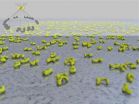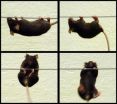(Press-News.org) LA JOLLA, CA – January 14, 2013 – Using an innovative approach, scientists at The Scripps Research Institute (TSRI) have determined the structure of Ltn1, a recently discovered "quality-control" protein that is found in the cells of all plants, fungi and animals.
Ltn1 appears to be essential for keeping cells' protein-making machinery working smoothly. It may also be relevant to human neurodegenerative diseases, for an Ltn1 mutation in mice leads to a motor-neuron disease resembling amyotrophic lateral sclerosis (ALS, also known as Lou Gehrig's disease).
"To better understand Ltn1's mechanism of action, we needed to solve its structure, and that's what we've done here," said TSRI Associate Professor Claudio Joazeiro.
"In addition, this project has brought us a set of structural analysis techniques that we can apply to other exciting problems in biology," said TSRI Professor Bridget Carragher.
Joazeiro and Carragher, along with Clint Potter, also a TSRI professor, are senior authors of the new report, which appears in the online Early Edition of the Proceedings of the National Academy of Sciences the week of January 14, 2013.
Links to Neurodegenerative Disease
Ltn1 first turned up on biologists' radar screens several years ago when a joint Novartis-Phenomix research team noted that mice with an unknown gene mutation were born normal but suffered from progressive paralysis. The scientists dubbed the animals lister mice, because they listed to one side as they walked. Collaborating with Joazeiro, the Novartis team reported in a 2009 paper that the mutated gene normally codes for a type of enzyme known as an E3 ubiquitin ligase, and that the mouse phenotype was due to a neurodegenerative syndrome resembling ALS.
In a study published in the journal Nature the following year, Joazeiro and his postdoctoral research associate Mario H. Bengtson found that the enzyme serves as a crucial quality-control manager for the cellular protein-making factories called ribosomes. Occasionally a ribosome receives miscoded genetic instructions and produces certain types of abnormal proteins, known as "nonstop proteins"— jamming the ribosomal machinery like a wrinkled sheet of paper in an office printer. Bengtson and Joazeiro found that Ltn1 fixes jammed ribosomes by tagging nonstop proteins with ubiquitin molecules, thereby marking them for quick destruction by roving cellular garbage-disposers called proteasomes.
"The question for us then was, "How does Ltn1 do this?' " said Joazeiro.
Pushing the Boundaries of Electron Microscopy
To help find out, he began a collaboration with Carragher and Potter, who run the National Resource for Automated Molecular Microscopy (NRAMM), an advanced electron microscope facility at TSRI that is funded by the National Institutes of Health's National Center for Research Resources.
Ltn1 was deemed too large for its structure to be determined by current nuclear magnetic resonance (NMR) technology, and, as the scientists know now, too flexible to allow the highly regular crystalline packing needed by X-ray crystallographers. "It's a very floppy molecule, so it would be hard to crystallize," said Potter.
Advanced electron microscopy offered a way, however. Dmitry Lyumkis, a graduate student in the NRAMM laboratory and first author of the study, took high-resolution images of yeast Ltn1 with an electron microscope. He then used sophisticated image and data processing software to align and average individual images. The technique eliminates much of the random "noise" that obscures single images and produces a sharp 3D picture of the protein.
No one has ever used electron microscopy to distinguish so many—more than 20—conformations of such a small protein. "Usually electron microscopists determine no more than two or three conformational states, and they work with protein complexes whose size is in the megadalton range, but Ltn1 is only 180 kilodaltons, an order of magnitude smaller," Lyumkis said.
An Unusually Flexible Structure
The analysis revealed that Ltn1 has an elongated, double-jointed and extraordinarily flexible structure with two working ends—the N-terminus and C-terminus. "We anticipate that the N-terminus is responsible for association with the ribosome and know that the C-terminus is responsible for the ubiquitylation of nonstop proteins," said Lyumkis. "We suspect that the high flexibility of this structure is needed for it to work on the variety of nonstop proteins that can get stuck in ribosomes."
One of the next steps for the team is to evaluate Ltn1's individual segments, which appear to be more rigid, using X-ray crystallography, in order to develop a piece-by-piece atomic-resolution model of the enzyme. Another is to determine the structure of Ltn1 when it is attached to a ribosome and operating on a nonstop protein. Joazeiro notes that a typical yeast cell has nearly 200,000 ribosomes but requires only 200 Ltn1 copies for adequate quality control under normal growth conditions. "Somehow this enzyme can efficiently sense which ribosomes are jammed, and we expect that by solving the joint structure of Ltn1 and a ribosome, we'll be able to understand how it does this," he says.
Lyumkis, Carragher, Potter and their colleagues at NRAMM also plan to use a similar electron microscopy-based approach to find the structures of other important proteins with highly variable "heterogeneous" conformations. "Heterogeneity has been a big challenge," said Potter, "and being able to collect this large dataset and do all of this data processing successfully has been a critical breakthrough."
INFORMATION:
Other contributors to the paper, "Single-particle EM reveals extensive conformational
variability of the Ltn1 E3 ligase," were Selom K. Doamekpor and Christopher D. Lima at the Sloan–Kettering Institute; Tasha B. Toro and Matthew D. Petroski of the Sanford-Burnham Medical Research Institute; and Mario H. Bengtson and Joong-Won Lee of TSRI.
The study was supported by grants from the National Center for Research Resources (RR017573); the National Institute of General Medical Sciences (GM103310); the National Institutes of Health (R01 GM083060, R01 NS075719, GM061906); and the American Cancer Society (RSG-11-224-01-DMC, RSG-08-298-01-TBE).
Scientists discover structure of protein essential for quality control, nerve function
2013-01-15
ELSE PRESS RELEASES FROM THIS DATE:
CU-led study shows pine beetle outbreak buffers watersheds from nitrate pollution
2013-01-15
A research team involving several scientists from the University of Colorado Boulder has found an unexpected silver lining in the devastating pine beetle outbreaks ravaging the West: Such events do not harm water quality in adjacent streams as scientists had previously believed.
According to CU-Boulder team member Professor William Lewis, the new study shows that smaller trees and other vegetation that survive pine beetle invasions along waterways increase their uptake of nitrate, a common disturbance-related pollutant. While logging or damaging storms can drive stream ...
Supplements and cow's milk play biggest roles in determining vitamin D levels in children
2013-01-15
TORONTO, Jan 14, 2013—Taking a vitamin D supplement and drinking cow's milk are the two most important factors that determine how much vitamin D is in a child's body, new research has found.
Those factors play a bigger role than even skin colour and exposure to the sun, according to Dr. Jonathon Maguire, a researcher and pediatrician at St. Michael's Hospital.
"Early childhood is a critical stage in human development, so achieving and maintaining optimal vitamin D levels in early childhood may be important to health outcomes in later childhood and adulthood," Dr. Maguire ...
NASA sees strength in newborn Tropical Cyclone Emang
2013-01-15
Tropical Cyclone Emang developed in the Southern Indian Ocean on Sunday, Jan. 13 about 525 nautical miles east-southeast of Diego Garcia. At that time, infrared satellite imagery revealed that the low level circulation center was partially exposed to outer winds, and there was a burst of thunderstorm development over the northwestern quadrant.
NASA's Tropical Rainfall Measuring Mission (TRMM) satellite captured rainfall rates in Tropical Storm Narelle on Jan. 13 at 0907 UTC (5:07 a.m. EST). Moderate and heavy rainfall was occurring around the center of circulation, where ...
New sunspots producing space weather
2013-01-15
On Jan. 13, 2013, at 2:24 a.m. EST, the sun erupted with an Earth-directed coronal mass ejection or CME. Not to be confused with a solar flare, a CME is a solar phenomenon that can send solar particles into space and reach Earth one to three days later.
Experimental NASA research models, based on observations from the Solar Terrestrial Relations Observatory (STEREO) and the ESA/NASA mission the Solar and Heliospheric Observatory, show that the CME left the sun at speeds of 275 miles per second. This is a fairly typical speed for CMEs, though much slower than the fastest ...
Patient expectations of acute bronchitis not consistent with the best evidence
2013-01-15
Athens, Ga. – New research from the University of Georgia exposes a large discrepancy in the length of time patients expect an acute cough illness, also called acute bronchitis, to last and the reality of the illness. This mismatch may be a factor in the over-prescription of antibiotics.
Examining the gap in patient expectations and the actual length of time the body takes to rid itself of a chest cold, Dr. Mark Ebell, associate professor of epidemiology in the UGA College of Public Health, recently published an article in the Annals of Family Medicine. His results show ...
Tamoxifen ameliorates symptoms of Duchenne muscular dystrophy
2013-01-15
Philadelphia, PA, January 15, 2013 – A new study has found that tamoxifen, a well-known breast cancer drug, can counteract some pathologic features in a mouse model of Duchenne muscular dystrophy (DMD). At present, no treatment is known to produce long-term improvement of the symptoms in boys with DMD, a debilitating muscular disorder that is characterized by progressive muscle wasting, respiratory and cardiac impairments, paralysis, and premature death. This study will be published in the February 2013 issue of The American Journal of Pathology.
Using the mdx5Cv mouse ...
Low birth weight not associated with asthma risk
2013-01-15
ARLINGTON HEIGHTS, Ill. (January 15, 2012) – Asthma is a serious condition that affects more than 25.7 million Americans, and is responsible for nearly 4,000 deaths annually. While the cause of asthma remains unknown, a study released today in the January issue of Annals of Allergy, Asthma and Immunology, the scientific journal of the American College of Allergy, Asthma and Immunology (ACAAI), has concluded that low birth weight is not associated with asthma risk in young children.
"Asthma is the most common chronic illness in childhood and is a leading reason for missed ...
Fetal exposure to PVC plastic chemical linked to obesity in offspring
2013-01-15
Irvine, Calif. — Exposing pregnant mice to low doses of the chemical tributyltin – which is used in marine hull paint and PVC plastic – can lead to obesity for multiple generations without subsequent exposure, a UC Irvine study has found.
After exposing pregnant mice to TBT in concentrations similar to those found in the environment, researchers saw increased body fat, liver fat and fat-specific gene expression in their "children," "grandchildren" and "great-grandchildren" – none of which had been exposed to the chemical.
These findings suggest that early-life exposure ...
Quality of instruction trumps language in reading programs for elementary-age ELLs
2013-01-15
WASHINGTON, January 14, 2013─New research synthesizes studies of English reading outcomes for Spanish-dominant English language learners (ELLs) in elementary schools. The review, Effective Reading Programs for Spanish-dominant English Language Learners (ELLs) in the Elementary Grades: A Synthesis of Research, appears in the December issue of Review of Educational Research, a journal of the American Educational Research Association (AERA).
Conducted by Alan C. K. Cheung, The Chinese University of Hong Kong, and Robert E. Slavin, Johns Hopkins University and the University ...
New research shows uncertain benefits after grade 2
2013-01-15
WASHINGTON, January 14, 2013─ Education researchers Paul Hanselman and Geoffrey D. Borman have evaluated the impact of literacy instruction in grades 3 through 5. Their findings were published in Educational Evaluation and Policy Analysis (EEPA) in Online First. EEPA is a peer-reviewed journal of the American Educational Research Association.
The researchers examined Success for All, an instructional approach that is among the most mature and proven school reform models, to identify impact on reading achievement among older elementary students. This study, a follow-up ...



